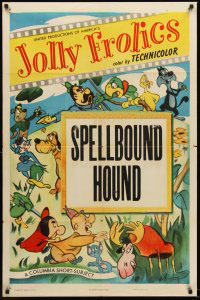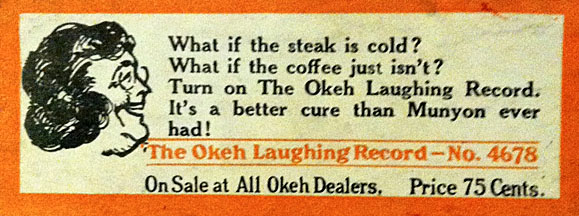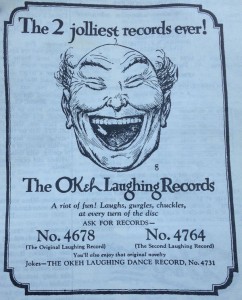All of the cartoons that used commercial records as part of their soundtracks came from the early to middle 1930’s.
By the late 1930’s, scoring of cartoons – always a big selling point from the time that talkies came into vogue – was being developed into an art.
 And by the 1950s, each cartoon studio had its own expert at scoring animation. Whether it was Carl Stalling, Scott Bradley, the swing-oriented Darrell Calker, or the more dance-band oriented likes of Philip Scheib or Clarence Wheeler, these cats knew how to use music to help put the cartoon’s story or mood across. There was no longer any necessity to raid the local record shop to get the musical background needed.
And by the 1950s, each cartoon studio had its own expert at scoring animation. Whether it was Carl Stalling, Scott Bradley, the swing-oriented Darrell Calker, or the more dance-band oriented likes of Philip Scheib or Clarence Wheeler, these cats knew how to use music to help put the cartoon’s story or mood across. There was no longer any necessity to raid the local record shop to get the musical background needed.
So, if a commercial record was needed, there was usually a good reason. And in two instances the records used were already old discs indeed.
Frank Crumit’s recording of “Frankie and Johnnie” had been a good seller in 1927. (It didn’t hurt that it was coupled with Crumit’s reading of “Abdul Abulbul Aimir” – which would be the subject of a Hugh Harman M-G-M cartoon of the early 1940’s.) So, when director John Hubley (himself a record collector) and composer Del Castillo (a radio organist who was drafted to score Robin Hoodlum, Ragtime Bear and several other shorts for UPA), needed an old record for Magoo’s windup, open-horn gramophone (which wound up on the fishing boat) in Spellbound Hound, the second Magoo cartoon, it was a natural choice.
Good laughs were sure to happen when Magoo mistook the turntable of this old talking machine for the outboard motor of his craft. So, when he tried to zip-start the thing, we heard Andy Sannella’s steel guitar and Crumit’s singing, with something of the effect of a hand-driven turntable, speed variations and everything.

A few years later, another studio put out another cartoon that was built around an old recording.
Back around 1919, the German record business was trying to get back in gear after the First World War. It wasn’t easy. Germany had lost the war. Then they lost the peace to “revanchist” forces that wanted to rub Germany’s nose in it. And the hyper-inflation that would soon consume Germany was just starting up.
One of the German labels, Beka, released an Original Lach-Aufnahme (“Original Laughing Record”), on which a man and a woman react to some inept cornet playing by breaking into laughter – first regular, then building up to an uproarious level.
Nobody knows who the participants in this disc were. Lore has it that the man was the keeper of a “bierkeller”–a tavern-keeper–and that the woman as his wife. What we do know is that the metal parts were shipped over here, and the record came out here in 1922, billed simply as “The OKeh Laughing Record” (OKeh 4678). The record was a big seller, prompting other record companies to come up with “cover” versions and other laughing specialties.
The record – originally coupled with a cornet solo of an air from “The Gypsy Baron” – was still in demand in 1930, when almost all other records on the market were made by the new electrical process. As the metal parts for the cornet solo had worn out, the side was re-coupled with, of all things, a ballad played by Louis Armstrong and his Orchestra.
And the demand for this old platter went on. A dubbing was made in 1936, adding a reject groove so that this disc could be played on juke boxes (!) and it was reissued anew in 1953, this time coupled with country singer Bob Atcher’s sobbing performance of “I’m Thinking Tonight Of My Blue Eyes”.
Enter Tex Avery.
Avery’s theatrical career was winding down. Soon he would be devoting his time and energy to the animated cucarachas whose last words were usually an incredulous “RA-A-AID??!!!”
 He was back at the Walter Lantz studio, where he put out a handful of cartoons, which suffered from lower budgets than he’d had at M-G-M, but which still had his spirit.
He was back at the Walter Lantz studio, where he put out a handful of cartoons, which suffered from lower budgets than he’d had at M-G-M, but which still had his spirit.
In a 1970’s interview, Avery remembered the “OKeh Laughing Record”, and wondered aloud how it would work if the house lights were to go dim, and the record were to be put on without any prior announcement. He wondered if the audience would be laughing just as much as the man and woman on the old record.
With his last cartoon for Lantz, Tex Avery got to try out his theory. Shh-h-h-h! (1955) was built entirely around the acoustically-recorded laughing record. The opening credits even acknowledge OKeh records in their text.
The story–dealing with a frazzled worker going off to a hush-hush (literally!) health spa in the Swiss Alps, only to be disturbed by a neighbor’s trombone playing and raucous laughter, might have seemed contrived. But it was a gentle way for Avery to leave theatrical cartoons behind.
Interesting to note that, although the record clearly features an ineptly-played trumpet, the cartoon makes it a trombone. Could this be that the trombone–derided by no less an authority as Sir Thomas Beecham as “an absurd piece of plumbing”–was deemed to be funnier than a cornet?
One wonders–especially when one considers Disney’s Trombone Trouble, a 1944 Duck cartoon that did not go for the “laughing record” tangent, but which had not only Donald Duck, but Jupiter and Vulcan up in the Heavens, disturbed by Peg Leg Pete’s performance on the old slush pump.
Or, there’s “The Jones Laughing Record”, in which a number of Spike Jones’ laughter-makers make laughter at an ill-considered attempt by a trombonist to play “The Flight of the Bumble Bee” on his ‘bone.
Go and figure!

NEXT WEEK: More Musical Madness!


 James Parten has overcome a congenital visual disability to be acknowledged as an expert on the early history of recorded sound. He has a Broadcasting Certificate (Radio Option) from Los Angeles Valley College, class of 1999. He has also been a fan of animated cartoons since childhood.
James Parten has overcome a congenital visual disability to be acknowledged as an expert on the early history of recorded sound. He has a Broadcasting Certificate (Radio Option) from Los Angeles Valley College, class of 1999. He has also been a fan of animated cartoons since childhood.












































The Okeh Laughing Record was regularly played on the Dr Demento Show which used to air here in SoCal on KMET FM 94.7. As you demonstrate above in SH-H-H-H, notice that the frazzled gentleman is a bongo player at wits end after getting blasted by the nightclub orchestra’s brass section every night.
I’ve heard that very funny show for years (well, used to!) and seen the cartoon…..then there was the use by many cartoon studios in the fifties thru early 70s of various libaries and such…but that’s for another time and maybe another columnist (I’d love to do somehting like that here..)
Yowp has already been doing research on the various “library” recordings used by Hanna-Barbera (and, also at times, by Clokey, and even on soundtracks of Screen Gems’ live-action “Dennis the Menace”) over at yowpyowp.blogspot.com. You might like to check these out–and actually hear what some of these themes sound like “clean”, without dialogue and sound effects.
I think the reason the cartoon didn’t provoke the desired reaction was the audience was set up at the outset to be sympathetic towards Mr. Twiddle, who ends up being the victim of the gags that play out under the Okeh Laughing Record, with the payoff being …. he dies. And the doctor, nurse and laughter continue on into the end titles.
As with Tex’s extended fall for Bugs and Willoughby at the end of “The Heckling Hare” it was a gamble by Avery that a situation could be made to seem funny to the audience over just straight gags. The first effort didn’t even make it all the way past Leon Schlesinger or Jack Warner before getting negative reviews (take your pick on who ordered the scene cut); the latter made it to the theaters as intended, but with a story that made the audience want to dislike the people who were laughing instead of laughing along with the record.
A tremendous post. Watching (repeatedly) this film on the WW Show, it was a true joy to learn of its history!!
Thanks for this post James, I really enjoyed the original German pressing of the Laughing Record. This record always makes me chuckle when I hear it as SOUND, but for some reason when paired with PICTURES, it takes on a surrealistic otherworldly tone. Tex may have made a mistake in SHHHH! by thinking that he could add a story, characters and sound effects over the Laughing Record and somehow get a great comedic result. What he achieved, in my opinion, is a cartoon like many of the Zagreb studio efforts, not really funny, but eerie and very strange. It’s almost like a horror picture after Mr. Twiddle blows up and the doctor and nurse keep on laughing and playing the trombone. “The Gypsy Baron”, is a sad, haunting little tune which as an underscore, is contrapuntal to comedy. But I really like SHHHH! as a horror cartoon.
I do too Mark. This cartoon was a nearly childhood memory that stayed with me for years. I sorta put it up there with similar unsettling shorts like Marv Newland’s Bambi Meets Godzilla or Paul Driessen’s “The Killing of an Egg”.
George S. Kaufman (who knew a few things about comedy) once advised to avoid characters laughing on stage because “it saves the audience the trouble.” There are those who disagree with that sentiment but this specific Tex Avery directed Walter Lantz cartoon goes a long way in proving it correct.
Speaking as a Chic Johnson fan, I think that laughing at one’s own material can become a bizarre (and funny) joke in its own right. But that’s not what’s happening here. The Okeh record invites you to laugh along; Avery’s narrative subverts everything that makes the record effective. Here, via Avery’s story, the laughter has been turned on its own sympathetic lead character.. and, by proxy, on the audience itself. For years, I’ve wondered if Tex truly hated the “laughing record” (or harbored other unspoken resentments) and deliberately clouded his intentions in interviews because it’s unthinkable that a man with his comic instincts could get this so completely wrong. It’s an incredibly bitter cartoon.
The cartoon always works for me, but what do I know?
The gags are quick and bizarre, and instead of underscoring each gag the record keeps the action in real time and emphasizes the man’s unseen enemies are totally unfazed by his increasingly violent attempts.
Nobody knows who the participants in this disc were.
Apparently the second video you included of the Okeh disc does give us the names anyway. An Otto Rathke and Lucie Bernardo are said to be the laughing couple, along with Felix Silbers as the coronet player (That first clip gives it away there were at least three people recording this together going by the laughter, I was impressed how clear that Odeon pressing was), apparently this was recorded on August 6th, 1920.
The Odeon pressing was an electric remake, as many companies would offer many of their best-sellers in new orthophonic process. Yes, the paticipants are mentioned in the second video. The poster of that video is an avid collector & gives more background info..
Must’ve been several variations of this in Germany as well, spotted this one featuring the same Lucie Bernardo for another label.
https://www.youtube.com/watch?v=fRVm-OuHHxM